Subscribe to EDOM TECH Newsletter
2018/01/30
Evolving Radio/Audio for Connected Cars
Article by : By Alick Einav, Silicon Labs
Changes in antennas, displays, in-vehicle networks and new digital radio standards have made car radios much more versatile, while bringing new challenges to car radio vendors.
New technologies are challenging automotive radio vendors to improve radio reception while meeting different sets of requirements and cost targets. Let’s consider some of these challenges and how new integrated circuit (IC) devices can help radio vendors tackle them.
Issues/challenges facing automotive radio vendors
Modern car radios look quite different from radios deployed in cars even ten years ago. Changes in antennas, displays, in-vehicle networks and new digital radio standards have made car radios much more versatile, but have also given rise to a suite of new challenges for car radio vendors. Here are some of the technological trends of modern radio systems in new vehicles.
Location of the radio system
The entire radio system in legacy designs used to be in the center console by the driver, with dedicated cables running from the antenna to the radio and from the radio to the speakers’ amplifiers (below, right). In contrast, many modern designs use the center console as a control center (as shown in Figure 1), which communicates with the radio system placed elsewhere, such as in the vehicle trunk, often in a location that is closer to the car’s antennas. Closer location to radio antennas reduces cabling costs and the vehicle’s weight, which consequently can help improve the vehicle’s mileage.
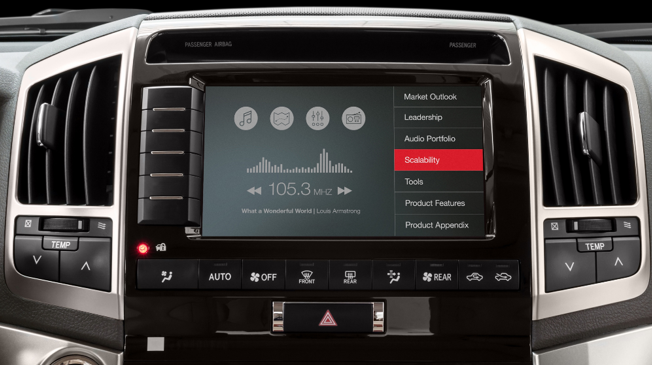
Figure 1. Location of traditional radio system in center console.
In-vehicle audio-video network
A growing number of car models deploy in-car audio-video networks, such as MOST or Ethernet AVB. The audio-video network runs around the cabin and enables each audio system to be placed in an optimal location in the vehicle, as shown in Figure 2. Thus, instead of running dedicated cables between the different audio systems, each audio system – such as radio or audio amplifiers – is connected to the network and can transmit or receive data to other audio systems over the network.
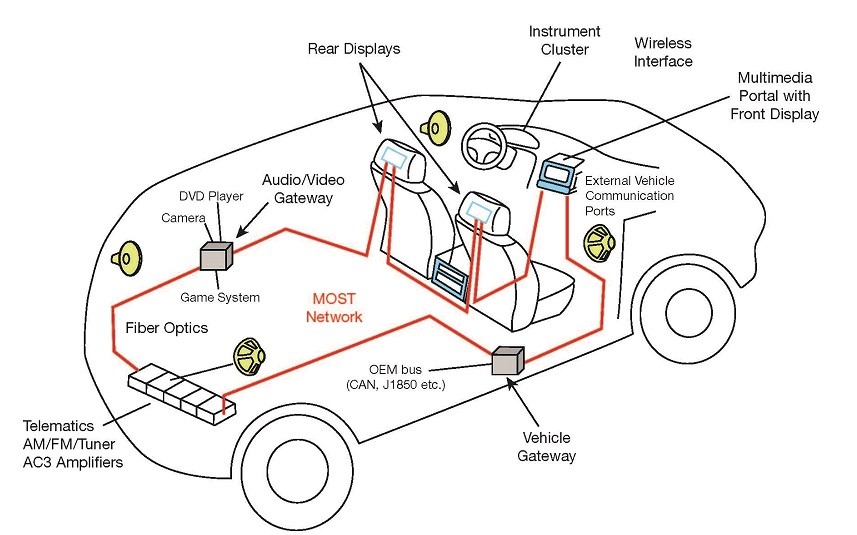
Figure 2. Audio-video network runs throughout the cabin in today’s vehicles.
Embedded radio antennas
Gone are the days when a long radio antenna protruded out of the car. Most modern cars embed radio antennas in the rear glass, side mirrors or a small shark fin structure placed on the car’s roof (see Figure 3 examples). Modern antennas enable a cleaner look for the vehicle, but introduce new challenges for good radio reception as these antennas come with low antenna gain.
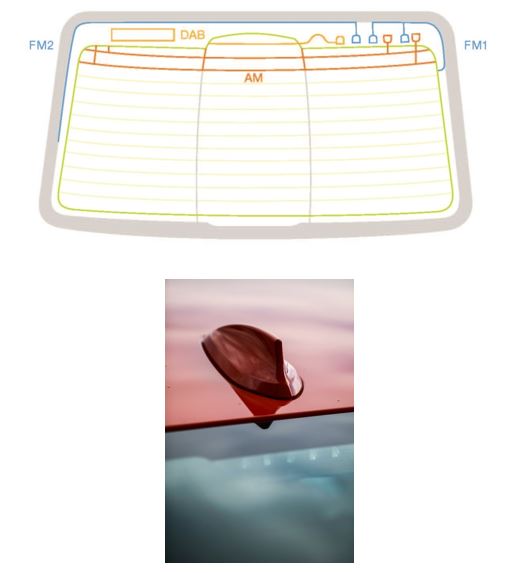
Figure 3. Radio antennas in modern cars are often embedded in the rear glass, side mirrors or roof-mounted shark fin structures.
Second antenna to improve FM reception (antenna diversity)
To improve FM reception, including reception challenges caused by embedded antennas, some car models deploy a secondary radio antenna. The secondary antenna, typically placed in a different location and pointing in a different direction from the primary radio antenna, enables the radio system to maintain good reception even when the radio signal received by the primary antenna is compromised by dynamic driving conditions.
Deployment of digital radio
In addition to the traditional analog radio (AM and FM), digital radio is now available in many countries. Different countries and regions have adopted different digital radio standards. For example, North America deploys HDRadio, Europe deploys DAB, India deploys DRM and China has just started to deploy CDR.
Digital radio stations transmit the radio in a digital format, which provides better audio quality as well as additional information to the driver (such as song name, artist name, etc.). Typically, music transmitted on a digital radio station is concurrently transmitted on an analog radio station, so that when the digital radio station signal starts going out of range, the radio may seamlessly switch to the same content on an analog station to maintain uninterrupted audio in the car.
DAB and DRM transmit on different bands than analog AM/FM, thereby requiring additional tuners and a second antenna optimized for digital radio frequencies. The digital radio may be offered with different sets of features, such as antenna diversity (which improves the reception of the digital radio just as antenna diversity improves the reception of the analog radio) or constant scan of the digital radio band to establish and present to the driver a list of available stations.
Digital radio is deployed in some but not all cars, forcing the radio vendors to develop radios with and without the digital radio. System variations, with and without the digital radio and with different features of the digital radio when present, further complicate the development and product offerings for radio vendors.
Improved/enhanced audio sound in the cabin
New and advanced digital signal processing technologies are used to improve the in-vehicle audio experience, enriching the car’s audio as well as mitigating the noise from the engine or from the road.
Car radios segmentation and price pressure
Radio systems deployed in cars are segmented by price into premium, mid-range and entry levels. Even within the same car model there will often be multiple levels of radio offerings. In addition, radio vendors need to support different digital radio standards, further complicating radio product offerings. These market trends leave radio vendors with the challenging task of developing different radio systems that achieve good radio reception while meeting cost targets required by car vendors.
Radio vendors have limited research and development budgets, which must be carefully managed to develop radio systems that can be profitably sold across as many car models as possible. No single radio vendor has enough resources to address all market segments of car radio systems. Therefore, radio vendors always look for ways to shorten radio development cycles, as well as leverage their R&D investment across as many car radio segments as possible. Software development captures an increasing portion of the radio development cycle, so reuse of both hardware and software development is critical.
Examples of different radio systems
Single AM/FM receiver (entry-level system). This radio system, shown in Figure 4, is located in the head unit in a central console and is controlled by a microcontroller, with the audio sent to the amplifiers.
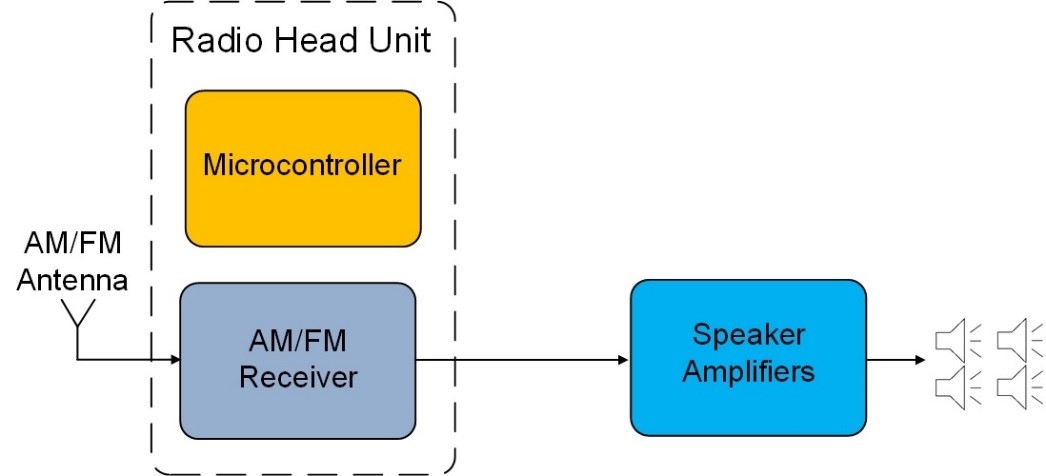
Figure 4. Entry-level radio system is located in a central console head unit
Two radio receivers with FM phase diversity and audio post-processing. As shown in Figure 5, this radio system resides in the head unit of the central console. The audio system may include a dedicated audio digital signal processor (DSP) for advanced audio post processing functions such as cabin equalization and surround sound.
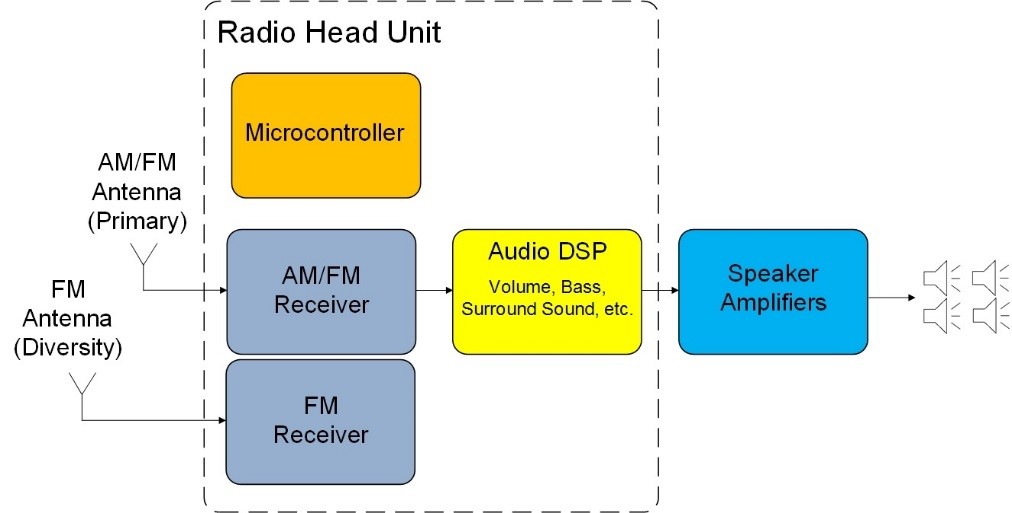
Figure 5. System with two radio receivers is located in the central console head unit
Remote radio system with two analog receivers with FM phase diversity and two DAB receivers (for digital radio reception in Europe). Two antennas receive the analog and the digital stations, as well as provide antenna diversity for both the analog and the digital reception. The system seamlessly links between the digital radio and the analog radio when the digital radio signal becomes too weak. The radio system includes an audio DSP for advanced audio post-processing functions such as cabin equalization and surround sound while also mitigating noise from the engine. The radio system may be located in the trunk or in another location outside the central console. Audio is either connected using the car network (using a microcontroller) or dedicated cables.
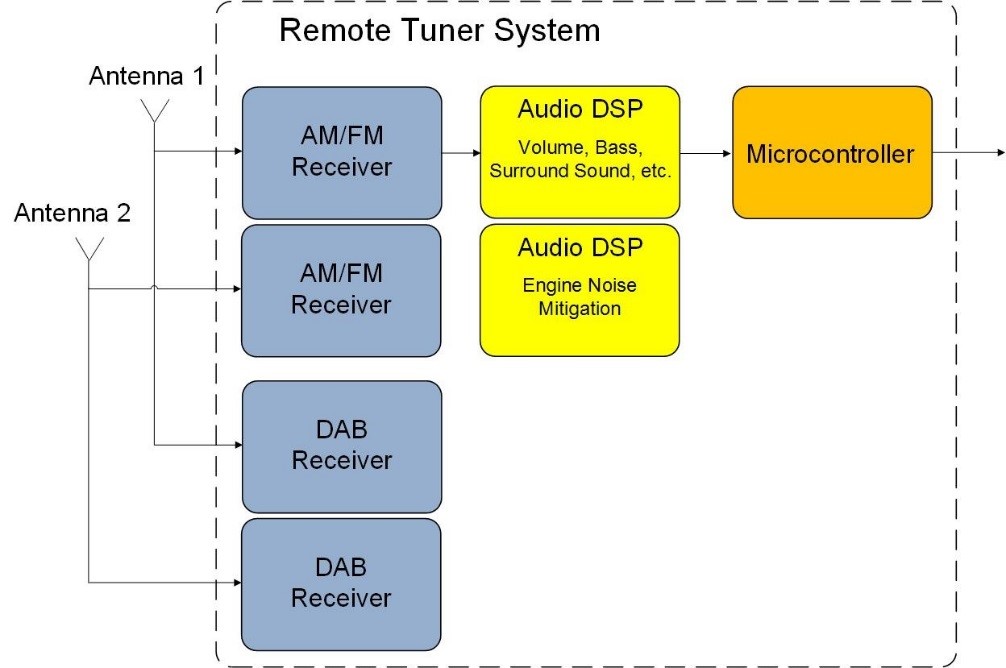
Figure 6. Multi-receiver remote radio system is located in the car trunk or another location outside the central console
New component solutions address modern radio design
New radio receiver ICs help radio vendors achieve optimal radio reception while reusing their hardware and software development across multiple product lines. For example, Silicon Labs’ new family of pin-compatible Global Eagle and Dual Eagle radio receivers enable car radio vendors to design one radio system that can cover many different radio system configurations at the lowest possible system cost. The radio receiver offering includes package and pin-compatible devices that support one or two radio receivers, enabling developers to scale radio systems with different population options in any given configuration. In addition, all devices in the Global Eagle and Dual Eagle family have the same application interface (API), thus enabling radio vendors to reuse software across many radio systems.
The devices also include a powerful audio DSP used to run audio control functions such as volume control, bass control, cabin equalization, surround sound and noise mitigation. Integrated analog-to-digital converters (ADCs) and digital-to-analog converters (DACs) eliminate the need for external CODECs.
Summary
Cars are undergoing a tremendous technological revolution on many fronts, and this trend extends to radio reception and audio/noise handling in the cabin. Car radio vendors must deal with many new technologies and diverging sets of requirements from car vendors, all while meeting aggressive cost targets and tight development schedules. New IC solutions enable radio vendors to develop radio systems that provide good radio reception and can scale from entry to premium systems at the lowest possible cost. Modern car radio systems far surpass any radio system deployed in cars ten years ago, and there is every indication that this trend will continue into the next decade.
Changes in antennas, displays, in-vehicle networks and new digital radio standards have made car radios much more versatile, while bringing new challenges to car radio vendors.
New technologies are challenging automotive radio vendors to improve radio reception while meeting different sets of requirements and cost targets. Let’s consider some of these challenges and how new integrated circuit (IC) devices can help radio vendors tackle them.
Issues/challenges facing automotive radio vendors
Modern car radios look quite different from radios deployed in cars even ten years ago. Changes in antennas, displays, in-vehicle networks and new digital radio standards have made car radios much more versatile, but have also given rise to a suite of new challenges for car radio vendors. Here are some of the technological trends of modern radio systems in new vehicles.
Location of the radio system
The entire radio system in legacy designs used to be in the center console by the driver, with dedicated cables running from the antenna to the radio and from the radio to the speakers’ amplifiers (below, right). In contrast, many modern designs use the center console as a control center (as shown in Figure 1), which communicates with the radio system placed elsewhere, such as in the vehicle trunk, often in a location that is closer to the car’s antennas. Closer location to radio antennas reduces cabling costs and the vehicle’s weight, which consequently can help improve the vehicle’s mileage.

Figure 1. Location of traditional radio system in center console.
In-vehicle audio-video network
A growing number of car models deploy in-car audio-video networks, such as MOST or Ethernet AVB. The audio-video network runs around the cabin and enables each audio system to be placed in an optimal location in the vehicle, as shown in Figure 2. Thus, instead of running dedicated cables between the different audio systems, each audio system – such as radio or audio amplifiers – is connected to the network and can transmit or receive data to other audio systems over the network.

Figure 2. Audio-video network runs throughout the cabin in today’s vehicles.
Embedded radio antennas
Gone are the days when a long radio antenna protruded out of the car. Most modern cars embed radio antennas in the rear glass, side mirrors or a small shark fin structure placed on the car’s roof (see Figure 3 examples). Modern antennas enable a cleaner look for the vehicle, but introduce new challenges for good radio reception as these antennas come with low antenna gain.

Figure 3. Radio antennas in modern cars are often embedded in the rear glass, side mirrors or roof-mounted shark fin structures.
Second antenna to improve FM reception (antenna diversity)
To improve FM reception, including reception challenges caused by embedded antennas, some car models deploy a secondary radio antenna. The secondary antenna, typically placed in a different location and pointing in a different direction from the primary radio antenna, enables the radio system to maintain good reception even when the radio signal received by the primary antenna is compromised by dynamic driving conditions.
Deployment of digital radio
In addition to the traditional analog radio (AM and FM), digital radio is now available in many countries. Different countries and regions have adopted different digital radio standards. For example, North America deploys HDRadio, Europe deploys DAB, India deploys DRM and China has just started to deploy CDR.
Digital radio stations transmit the radio in a digital format, which provides better audio quality as well as additional information to the driver (such as song name, artist name, etc.). Typically, music transmitted on a digital radio station is concurrently transmitted on an analog radio station, so that when the digital radio station signal starts going out of range, the radio may seamlessly switch to the same content on an analog station to maintain uninterrupted audio in the car.
DAB and DRM transmit on different bands than analog AM/FM, thereby requiring additional tuners and a second antenna optimized for digital radio frequencies. The digital radio may be offered with different sets of features, such as antenna diversity (which improves the reception of the digital radio just as antenna diversity improves the reception of the analog radio) or constant scan of the digital radio band to establish and present to the driver a list of available stations.
Digital radio is deployed in some but not all cars, forcing the radio vendors to develop radios with and without the digital radio. System variations, with and without the digital radio and with different features of the digital radio when present, further complicate the development and product offerings for radio vendors.
Improved/enhanced audio sound in the cabin
New and advanced digital signal processing technologies are used to improve the in-vehicle audio experience, enriching the car’s audio as well as mitigating the noise from the engine or from the road.
Car radios segmentation and price pressure
Radio systems deployed in cars are segmented by price into premium, mid-range and entry levels. Even within the same car model there will often be multiple levels of radio offerings. In addition, radio vendors need to support different digital radio standards, further complicating radio product offerings. These market trends leave radio vendors with the challenging task of developing different radio systems that achieve good radio reception while meeting cost targets required by car vendors.
Radio vendors have limited research and development budgets, which must be carefully managed to develop radio systems that can be profitably sold across as many car models as possible. No single radio vendor has enough resources to address all market segments of car radio systems. Therefore, radio vendors always look for ways to shorten radio development cycles, as well as leverage their R&D investment across as many car radio segments as possible. Software development captures an increasing portion of the radio development cycle, so reuse of both hardware and software development is critical.
Examples of different radio systems
Single AM/FM receiver (entry-level system). This radio system, shown in Figure 4, is located in the head unit in a central console and is controlled by a microcontroller, with the audio sent to the amplifiers.

Figure 4. Entry-level radio system is located in a central console head unit
Two radio receivers with FM phase diversity and audio post-processing. As shown in Figure 5, this radio system resides in the head unit of the central console. The audio system may include a dedicated audio digital signal processor (DSP) for advanced audio post processing functions such as cabin equalization and surround sound.

Figure 5. System with two radio receivers is located in the central console head unit
Remote radio system with two analog receivers with FM phase diversity and two DAB receivers (for digital radio reception in Europe). Two antennas receive the analog and the digital stations, as well as provide antenna diversity for both the analog and the digital reception. The system seamlessly links between the digital radio and the analog radio when the digital radio signal becomes too weak. The radio system includes an audio DSP for advanced audio post-processing functions such as cabin equalization and surround sound while also mitigating noise from the engine. The radio system may be located in the trunk or in another location outside the central console. Audio is either connected using the car network (using a microcontroller) or dedicated cables.

Figure 6. Multi-receiver remote radio system is located in the car trunk or another location outside the central console
New component solutions address modern radio design
New radio receiver ICs help radio vendors achieve optimal radio reception while reusing their hardware and software development across multiple product lines. For example, Silicon Labs’ new family of pin-compatible Global Eagle and Dual Eagle radio receivers enable car radio vendors to design one radio system that can cover many different radio system configurations at the lowest possible system cost. The radio receiver offering includes package and pin-compatible devices that support one or two radio receivers, enabling developers to scale radio systems with different population options in any given configuration. In addition, all devices in the Global Eagle and Dual Eagle family have the same application interface (API), thus enabling radio vendors to reuse software across many radio systems.
The devices also include a powerful audio DSP used to run audio control functions such as volume control, bass control, cabin equalization, surround sound and noise mitigation. Integrated analog-to-digital converters (ADCs) and digital-to-analog converters (DACs) eliminate the need for external CODECs.
Summary
Cars are undergoing a tremendous technological revolution on many fronts, and this trend extends to radio reception and audio/noise handling in the cabin. Car radio vendors must deal with many new technologies and diverging sets of requirements from car vendors, all while meeting aggressive cost targets and tight development schedules. New IC solutions enable radio vendors to develop radio systems that provide good radio reception and can scale from entry to premium systems at the lowest possible cost. Modern car radio systems far surpass any radio system deployed in cars ten years ago, and there is every indication that this trend will continue into the next decade.






